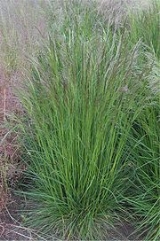
Tufted Hair-grass
Encyclopedia
Deschampsia cespitosa, commonly known as Tufted Hair-grass or Tussock grass is a perennial tufted plant in the grass family Poaceae
. Distribution of this Deschampsia
grass species is widespread including the eastern and western coasts of North America, parts of South America, and Eurasia.
- Holcus lanatus to Deschampsia cespitosa Mesotrophic grasslands. It can exist up to altitudes of 4000 ft.
A distinguishing feature is the upper surface of the leaf blade which feels rough and can cut in one direction, but is smooth in the opposite direction. The upper side of the leaves are deeply grooved, and are dark green.
It can grow to 1.5 metres tall, and has a long, narrow, pointed ligule.
It flowers from June until August.
s, such as the California coastal prairie
, are Festuca californica
, Festuca idahoensis
, Danthonia californica
, and Nassella pulchra
.
Poaceae
The Poaceae is a large and nearly ubiquitous family of flowering plants. Members of this family are commonly called grasses, although the term "grass" is also applied to plants that are not in the Poaceae lineage, including the rushes and sedges...
. Distribution of this Deschampsia
Deschampsia
Deschampsia is a genus of grasses in the family Poaceae, commonly known as hair grass or tussock grass. There are 30 to 40 species....
grass species is widespread including the eastern and western coasts of North America, parts of South America, and Eurasia.
Description
It can be found on all types of grassland, although it prefers poorly drained soil. It forms a major component of the British NVC community MG9British NVC community MG9
British NVC community MG9 is one of the mesotrophic grassland communities in the British National Vegetation Classification system. It is one of three communities associated with poorly-drained permanent pastures.It is a widespread community throughout the British lowlands...
- Holcus lanatus to Deschampsia cespitosa Mesotrophic grasslands. It can exist up to altitudes of 4000 ft.
A distinguishing feature is the upper surface of the leaf blade which feels rough and can cut in one direction, but is smooth in the opposite direction. The upper side of the leaves are deeply grooved, and are dark green.
It can grow to 1.5 metres tall, and has a long, narrow, pointed ligule.
It flowers from June until August.
North America
Typical native grass associates in the western North American coastal prairieCoastal prairie
Coastal prairie may refer to either:* The California coastal prairie, a plant community found along the coasts of California and Oregon* The Western Gulf coastal grasslands of Louisiana, Texas, and Tamaulipas...
s, such as the California coastal prairie
California coastal prairie
California coastal prairie, also known as northern coastal grassland, is a grassland plant community of California and Oregon in the Temperate grasslands, savannas, and shrublands Biome...
, are Festuca californica
Festuca californica
Festuca californica is a species of grass known by the common name California fescue. It is native to the United Mexican States where it is a member of many plant communities, including chaparral. This fescue is a clumping bunch grass perennial without rhizomes.It reaches anywhere from 40 to 120...
, Festuca idahoensis
Festuca idahoensis
Festuca idahoensis is a species of grass known by the common names Idaho fescue and blue bunchgrass. It is native to western North America, where it is widespread and common...
, Danthonia californica
Danthonia californica
Danthonia californica is a species of grass known by the common name California oatgrass. This plant is native to two separate regions of the Americas, western North America from California to Saskatchewan, and Chile.-Description:...
, and Nassella pulchra
Nassella pulchra
Nassella pulchra is a species of grass known by the common name purple needlegrass. It is native to California, where it occurs throughout the coastal hills, valleys, and mountain ranges, as well as the Sacramento Valley and parts of the Sierra Nevada foothills, and Baja California.It grows in many...
.

